Microsoft: 9 Best Moves Of 2014Microsoft: 9 Best Moves Of 2014
After a rocky 2013, Microsoft bounced back this year. Here's what worked.

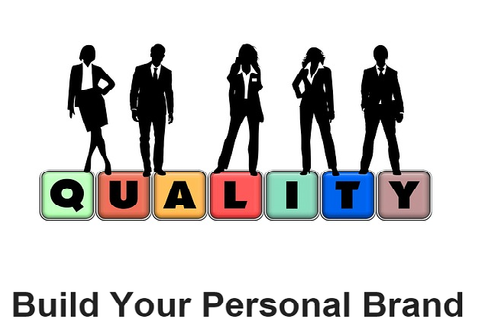
10 Ways To Improve Your Personal Brand
10 Ways To Improve Your Personal Brand (Click image for larger view and slideshow.)
For Microsoft, 2014 has been a terrific year. The company's stock reached its highest levels in a decade. Its overall financials are strong despite ongoing weak spots, such as consumer demand for PCs. Microsoft is releasing new and intriguing products at a faster pace than ever, especially in the cloud. Even Surface sales are up.
Compare this picture to the one Microsoft faced in 2013. The company spent the second half of the year licking its wounds, which included a near-$1 billion write-down on unsold Surface inventory as well as poor Windows 8 reviews and crashing PC sales. Rumors that shareholders were tired of CEO Steve Ballmer swirled, and, coincidentally or not, Ballmer announced in late summer that he was stepping down. As 2014 began, many commentators argued that Microsoft needed to bring in an experienced outsider to rehabilitate the dysfunctional culture Ballmer was perceived to have built.
Microsoft has left behind some of that tumult but challenges remain. The company absorbed thousands of talented Nokia employees, but no one's excited to see them dedicate all their time to low-budget smartphones. It's unclear if revenue from Microsoft's cloud and services businesses will scale fast enough to counter dropping revenue from consumer Windows licenses. And so on.
Even so, Microsoft has come a long way in a short time. How did so much change so quickly? Here are nine of Microsoft's best moves from 2014.
1. Satya Nadella became CEO.
Nadella, a longtime Microsoft veteran, has generally defied critics who said an insider would only perpetuate what Ballmer established. The new CEO has shown a willingness to blaze his own trail, such as establishing a more open dynamic with customers and partners, and repositioning Windows as a supporting asset in a cross-platform, mobile, and cloud-focused game plan.
Figure 1: 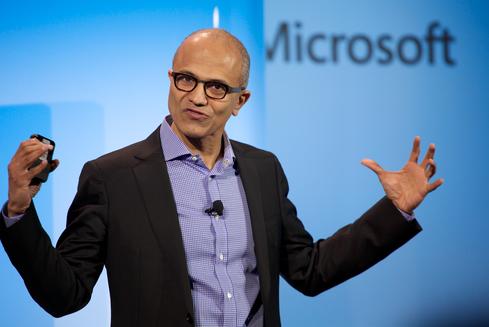 Microsoft CEO Satya Nadella
Microsoft CEO Satya Nadella
Nadella's made a few missteps, such as a high-profile and terribly articulated comment about gender pay. He'll also face tough challenges in 2015, such as convincing all the customers who've ignored Windows 8 that they should upgrade to Windows 10. But on the whole, Nadella led the Microsoft charge in 2014, which makes his ascension to CEO one of the company's best moves of the year.
2. "Devices and services" became "productivity and platforms."
Critics blasted Ballmer's "devices and services" mantra as tinged with Apple envy and impractical for Microsoft's enterprise strengths. Under Nadella, Microsoft continues to make devices, including pure consumer plays such as the Xbox. But the new CEO has made clear that these are supporting assets that draw users toward new technologies and services, not core assets in the sense that Ballmer seemed to envision.
Instead, Nadella has called Microsoft a "platforms and productivity" company whose software products and cloud infrastructure move with users across devices and OS ecosystems. Examples of this new focus include new cross-platform Office 365 apps that use machine learning to make productivity more social and personalized, such as Clutter and Delve. How it all shakes out remains to be seen, but Microsoft looks as if it's building its own innovative identity again, instead of just reacting to more agile and visionary peers.
3. Windows 10 drops the hubris and brings back the Start menu.
With Windows 8, Microsoft took some calculated risks -- namely, that it held enough leverage over its customers to force them to accept Win 8's tile-based UI. This strategy backfired, but with Windows 10, Microsoft appears to have learned its lesson.
Figure 2: 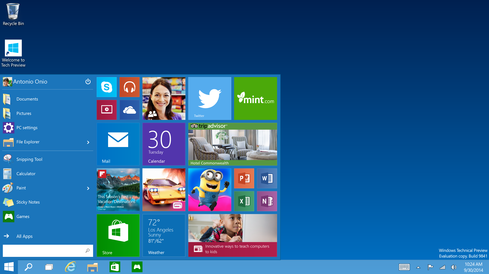 Windows 10 has a Start menu. But does it also represent a more open dialogue between Microsoft and customers?
Windows 10 has a Start menu. But does it also represent a more open dialogue between Microsoft and customers?
Some of the reasons for optimism are obvious: The Start menu is coming back; and Microsoft is finally implementing useful features that competing OSs offer, such as virtual desktops, etc. But beyond new features and UI tweaks, Microsoft is listening to customers. With
the final version of the OS still around nine months away, it remains to be seen how Microsoft follows through. But with the Windows 10 Technical Preview, the company has been relying on user feedback to shape changes. That's a big step in the right direction.
4. Microsoft made visible strides into wearables and the Internet of Things.
These developments are still fairly nascent, but after missing the user shift from PCs to mobile devices, Microsoft seems determined not to miss the next disruptive trend. In recent months, the company introduced a cloud-based analytics portfolio to make sense of data drawn from the Internet of Things (IoT). It also beat Apple to the wearables market and promised that Windows 10 will run on virtually anything that computes, from PCs and the Xbox to wearables and IoT devices. The OS won't be identical across so many device types, but the promise of simplified device management and common frameworks for developers and users could give Microsoft an edge as IoT apps become more common.
Figure 3: 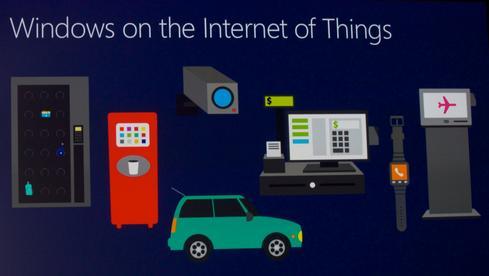 Microsoft execs say Windows 10 will play a role in the Internet of Things.
Microsoft execs say Windows 10 will play a role in the Internet of Things.
5. Microsoft has continued to beat the hybrid cloud drum.
Even before Ballmer stepped down, Microsoft execs argued the company's investments in hybrid cloud products would give it an edge. Nadella has accelerated this theme, and for good reason: It appears to be true. Businesses can enjoy greater agility and economies of scale by moving some workloads to the cloud, but everyone will do so at different paces, with some data destined to remain locked down in on-premises servers for years to come. Close ties between Windows Server and Azure allow customers to incrementally and flexibly step into the cloud. These ties also give Microsoft a valuable expertise that neither Google nor Amazon -- its closest cloud competitors -- can currently match.
6. Windows protectionism is out; iOS and Android software are in.
It's hard to imagine that Windows will ever be as popular on mobile devices as it's been on desktops. Nadella has responded to this reality by bringing Microsoft's software to users, whichever platform they happen to use.
Ballmer deserves some credit here, as he reportedly gave the command to release Office for iPad on his way out the door. But Nadella has embraced the idea to an extent that would have seemed heretical to his predecessor. Today's Microsoft still cares about Windows and will have a lot to prove with Windows 10 in 2015. But the company also recognizes that Office won't be the productivity standard if it's tethered to Windows. In a multi-device world, owning the premier productivity software could be more valuable than owning the most popular OS.
Figure 4: 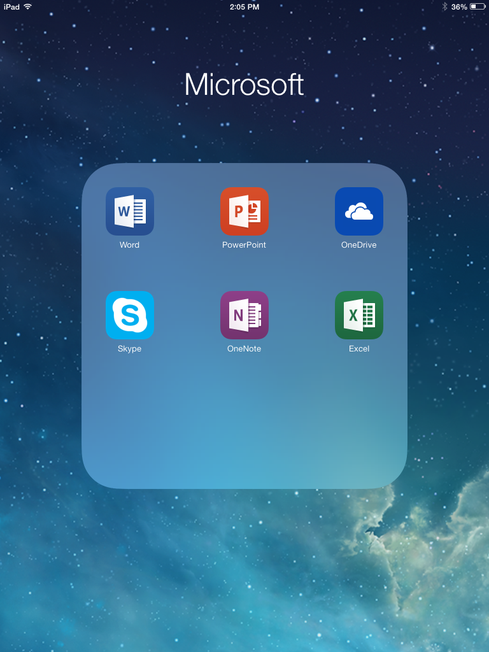 Cross-platform products such as the Office for iPad apps represent a significant shift in Microsoft strategy.
Cross-platform products such as the Office for iPad apps represent a significant shift in Microsoft strategy.
This strategy extends to Azure, too. Microsoft's cloud platform began mostly as a vehicle for first-party products and services, but its capabilities have grown increasingly flexible, diverse, and open. It still factors into the Windows ecosystem, forming the foundation for Microsoft's hosted services and hooking into Windows Server. But it can also handle workloads of all stripes, with more capabilities added all the time. These moves should pay off. After all, if Microsoft can’t get developers to write for Windows Phone instead of iOS, perhaps Microsoft can get those developers to host their apps in Azure instead of someone else’s cloud.
7. Microsoft explored subscriptions with a fighter's mentality.
Office 365 is gaining steam, but many users prefer to own their software, not rent it. Microsoft will likely need years to convince some of its customers that recurring subscriptions are better
than standalone software licenses. Moreover, even if users are interested in cloud-based subscriptions, Microsoft isn't the only game in town, with Google, Apple, Dropbox, and many others occupying the same spaces.
Microsoft's move to subscriptions will pose big challenges in coming years, especially as the subscription model inevitably creeps into some parts of Windows. But the company has responded to increased competition and user skepticism with shrewd, aggressive moves: throwing unlimited OneDrive cloud storage into Office 365 packages, bundling free subscriptions with many new Windows devices, expanding Office for iPad's free functionality, etc. These are measured, long-term moves, designed to ease users into changes, and to sacrifice upfront revenue if it means Office remains the productivity standard over the long run.
8. Microsoft met developers where they stand.
A year ago, Microsoft was throwing incentives at developers to build touch apps for its platforms. Today, rather than trying to pull developers into its ecosystem, Microsoft is meeting them where they stand. Moves range from the opening-sourcing of .NET to repositioning Bing as not only a search engine but also a development platform that can build apps for both Windows and third-party OSs. Microsoft still wants developers to build Windows apps and will have to prove that Windows 10's app model, which is supposed to let developers easily build apps for a range of devices, is worthwhile. But under Nadella, Microsoft has become more collaborative and more willing to help developers build apps for non-Windows platforms.
9. Microsoft eliminated Windows licenses for most consumer devices.
Last spring, Microsoft announced that Windows would be free to manufacturers building smartphones and other devices with screens smaller than nine inches. Thanks to this and similar efforts, such as Windows 8.1 with Bing, OEMs have flooded the market with cheap Windows devices, some of which are less than $100. While Windows Phone and Windows 8.1 are far from popular, Microsoft and its partners appear to have reached a sweet spot between cost and functionality; after small month-over-month increases for most of the year, Windows 8.1 market share has begun to climb since the budget devices became available.
Figure 5: 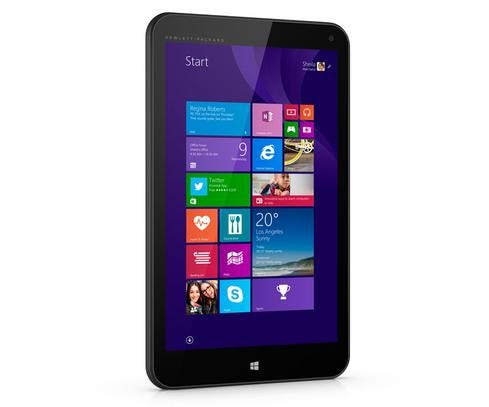 Thanks to Microsoft's new licensing terms, inexpensive Windows tablets such as HP's $100 Stream have flooded the market.
Thanks to Microsoft's new licensing terms, inexpensive Windows tablets such as HP's $100 Stream have flooded the market.
Microsoft isn't making money from these new device sales, but it hopes to cash in over the long run; as mentioned earlier, many of these low-cost tablets and laptops come with free Office 365 subscriptions, at least some of which will become recurring renewals. Lack of immediate profit aside, the cheap devices also help Microsoft block Chromebooks from eating into the low-end computing market segment. Windows remains a work in progress, but compared to where it sat a year ago, Microsoft is in much better shape.
Apply now for the 2015 information Elite 100, which recognizes the most innovative users of technology to advance a company's business goals. Winners will be recognized at the information Conference, April 27-28, 2015, at the Mandalay Bay in Las Vegas. Application period ends Jan. 16, 2015.
About the Author
You May Also Like






